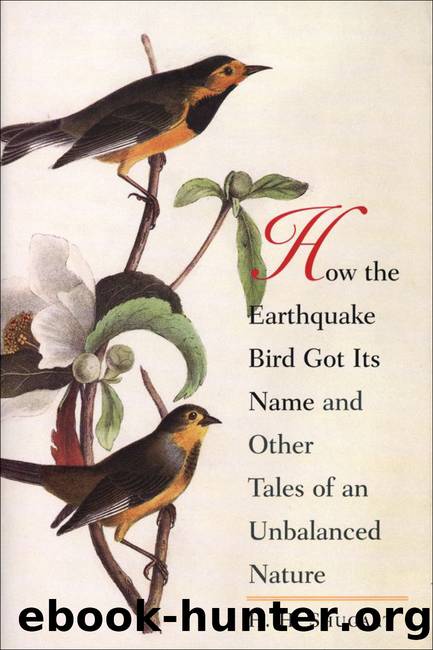How the Earthquake Bird Got Its Name and Other Tales of an Unbalanced Nature by H.H. Shugart

Author:H.H. Shugart [Shugart, H.H.]
Language: eng
Format: epub
ISBN: 9780300128604
Publisher: YaleUP
Published: 2004-09-15T05:00:00+00:00
Figure 30. Extinction pattern of birds in New Zealand. The shaded portions of the circles indicate the proportion of the species and subspecies found in each habitat that became extinct in New Zealand during the past millennium. The numbers in the circles indicate the total diversity of species and subspecies associated with each of the habitat types. From A. J. Anderson, Prehistoric Polynesian impact on the New Zealand environment: Te Whenua Hou (pp. 271 -283), in P. V. Kirch and T. L. Hunt, eds., Historical Ecology in the Pacific Islands (New Haven: Yale University Press, 1995).
⢠Extinct species were large birds, often the largest of their kind. This trait was found in both flying and flightless species.
⢠The flightless species on an island were more likely to become extinct. Those that did were often active by day and were primarily found in forest-edge habitats.
⢠The extinct species were more likely to have been ground-nesting birds.
⢠Colonial nesting species were particularly prone to extinction.
⢠Extinct species were more likely to lay a few large eggs than surviving species, which lay larger clutches of smaller eggs.
⢠On a given island, the species found only there (endemics) were more likely to become extinct than more widespread species.
The recently extinct birds of the Hawaiian Islands have been well studied compared to those of other islands and provide an excellent comparison to New Zealand.
Storrs Olson and Helen James have summarized twenty years of their work in identifying and classifying bird species from thousands of bones found in sites in the Hawaiian Islands.19 They described, among other marvels, a collection of highly modified, flightless, goose-like ducks (Figure 31) with turtle-like beaks.20 These unusual animals appear to have occupied the roles often filled by tortoises (large herbivores with cutting or shearing beaks) on remote islands such as the Galápagos. Olson and James devised a collective common name for these creatures: moa-nalo. The neologism comes from nalo, which in Hawaiian means lost, vanished, or forgotten, and moa, which refers to fowl. In other Polynesian languages, moa carries the sense of a bird and also of edibility. Moa certainly appears to have had the latter connotation in New Zealand. The fruit bat, a favorite food of Polynesians in the Cook Islands, is known as moa-kirikiri, meaning leather chicken. The moa-nalo shared the same fate as the moas of New Zealand, vanishing with the colonization of the Hawaiian Islands by voyaging Polynesians in A . D .300.
The extinct fossil birds of the Hawaiian Islands may number more than sixty species.21 In the 200 years of naming the birds of Hawaii since the arrival of Europeans, fifty-five living endemic bird species have been described. These described species might number as few as forty if classified by more conservative taxonomists inclined to âlumpâ species. Olson and Jamesâs identification from thousands of bird bones of as many extinct species as the thirty ornithologists who worked with living species over the previous 200 years cannot be overstated; it is simply a remarkable body of work.
Download
This site does not store any files on its server. We only index and link to content provided by other sites. Please contact the content providers to delete copyright contents if any and email us, we'll remove relevant links or contents immediately.
Sapiens: A Brief History of Humankind by Yuval Noah Harari(14258)
The Tidewater Tales by John Barth(12610)
Mastermind: How to Think Like Sherlock Holmes by Maria Konnikova(7236)
Do No Harm Stories of Life, Death and Brain Surgery by Henry Marsh(6891)
The Thirst by Nesbo Jo(6838)
Why We Sleep: Unlocking the Power of Sleep and Dreams by Matthew Walker(6620)
Life 3.0: Being Human in the Age of Artificial Intelligence by Tegmark Max(5480)
Sapiens by Yuval Noah Harari(5298)
The Longevity Diet by Valter Longo(5021)
The Body: A Guide for Occupants by Bill Bryson(4979)
The Rules Do Not Apply by Ariel Levy(4870)
The Immortal Life of Henrietta Lacks by Rebecca Skloot(4529)
Animal Frequency by Melissa Alvarez(4400)
Why We Sleep by Matthew Walker(4366)
The Hacking of the American Mind by Robert H. Lustig(4319)
Yoga Anatomy by Kaminoff Leslie(4310)
All Creatures Great and Small by James Herriot(4239)
Double Down (Diary of a Wimpy Kid Book 11) by Jeff Kinney(4210)
Embedded Programming with Modern C++ Cookbook by Igor Viarheichyk(4112)
